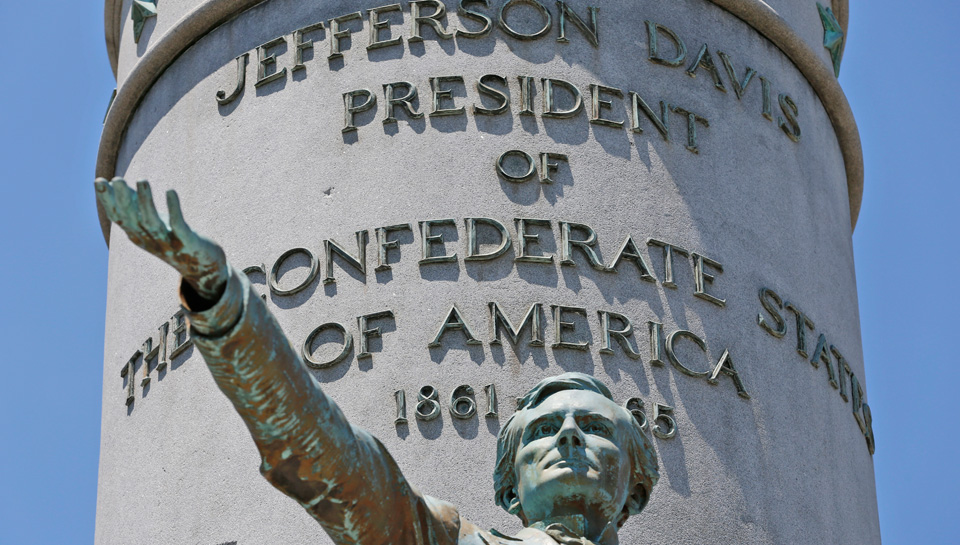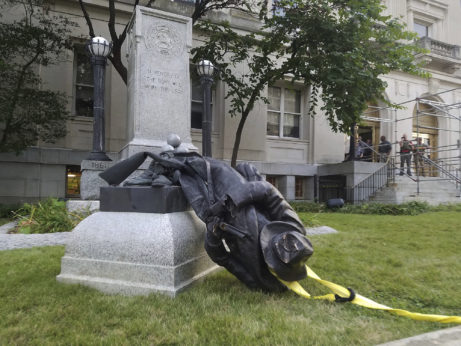
The issue of the hundreds of statues, monuments, schools, streets, and highways that bear the names of long-dead Confederate soldiers and politicians continues to roil the state of Virginia. The state chapter of the NAACP, the ACLU, and many other organizations have been calling for these names to be changed. Yet there are still powerful people in the state who are offended by efforts to remove these symbols of slavery and Jim Crow.
Before the crime and tragedy in Charlottesville, which cost the life of one woman and injured many more, proposals had been made to remove other monuments and change some names of streets and schools, but it was slow going and not only the Republican ultra-right expressed doubts.
Now it would appear that Charlottesville is going to encourage this movement rather than cow it into silence, as the fascists had wanted to do. One is reminded of the boost that was given to the movement to remove Confederate flags after the white supremacist terrorist Dylann Roof murdered nine parishioners of a mostly African-American church in Charleston, South Carolina in June 2015.
A case in point is Richmond, now Virginia’s capital and formerly the capital of the separatist Confederate States of America. The African-American mayor of this majority-minority city of 220,000 people, Levar Stoney, had not been keen up to now on removing the statues that are all over the city but most prominent along Monument Avenue, the high-visibility site of many public events.
There are statues of some of the most important Confederate leaders, erected from the 1890s through the 1920s with the specific purpose of glorifying the lost cause of the “gallant South,” in other words, of slavery and Jim Crow.
The mentality behind the creation and perpetuation of the statues was clearly shown in 1995, when it was proposed that a statue also be erected to the late Arthur Ashe, the African-American tennis great and Richmond native who had died two years earlier. In all seriousness, some people in the city complained that this would be inappropriate, because Ashe had nothing to do with the Confederacy, and at hearings on the matter, some people showed up in Confederate military uniforms to drive that point home. The statue was erected anyway.
Who were the heroes immortalized in stone on Richmond’s Monument Avenue?
*Jefferson Davis, a former federal army officer, cotton planter, and slave owner. He fought in the Mexican-American War of 1846-48, and also served in the antebellum House of Representatives and U.S. Senate. He was the Secretary of War in the Cabinet of President Franklin Pierce. When the Civil War broke out, Davis forgot his oath as a U.S. Army officer and was quickly chosen as the first president of the Confederate States of America. He proved to be incompetent in this role, which many historians think helped to bring about the South’s defeat. An ardent racist and arrogant elitist, Davis brought disgrace upon himself with a January 1863 order authorizing the execution of all captured federal officers serving under Union General Benjamin Butler. He also ordered that all Union officers commanding African-American troops be summarily executed, while all such troops be “returned” to slavery. Abraham Lincoln’s government immediately announced that it would execute a captured Confederate serviceman for every captured Union officer executed, and if captured Black Union troops were made slaves, captured Confederate soldiers would be forced to do hard labor. Davis backed down a bit, but some captured surrendered African-American soldiers were indeed murdered by Southern troops. Also, Davis’ refusal to recognize African-American soldiers as legitimate combatants meant that prisoner exchanges could not take place, causing unnecessary suffering for soldiers and their families on both sides. Yet, not only does Jefferson Davis have statues in Richmond and elsewhere, but the main road that runs past this writer’s home is called the “Jefferson Davis Highway” (U.S. Route 1). The city of Arlington is now in the process of changing the name of that part of U.S. Route 1 that passes through it.
*Robert E. Lee, commander-in-chief of the Army of Northern Virginia. Like Davis, he fought in the Mexican-American War and was commandant of the West Point military academy at one point. He gained notoriety by ordering the whipping of slaves at his family’s Arlington plantation, now the site of Arlington National Cemetery. Lee violated his oath as a U.S. Army officer when the Civil War broke out. He is more lionized and mythologized than any of the other Confederate heroes. He was a better general than some of the federal ones he faced on the battlefield, but nearly ruined the Confederate Army by his overly aggressive, adventuristic tactics, especially at the Battle of Gettysburg, where he threw away the lives of thousands of his men in the ill-conceived Pickett’s Charge. Like Davis, and unlike his second-in-command at Gettysburg, General James Longstreet, Lee remained a racist until the end of his days, but there are hundreds of statues, streets, and schools named in his honor—not in spite of his racist background, but because of it.
*Thomas “Stonewall” Jackson. Another career military officer, “Stonewall” Jackson was a former teacher at the Virginia Military Institute, where he gained a lifelong reputation as a humorless disciplinarian. He too was a slave owner and justified slavery with reference to the Bible, as he was a religious fanatic. Jackson was considered one of the South’s more able generals, but was accidentally killed by his own men at the battle of Chancellorsville in May 1863, so how he would have adjusted to postwar, post-slavery life is unknown and unknowable. In the wake of the Charlottesville horror, two of his great grandsons wrote to Mayor Stoney asking that their ancestor’s statue be taken down, arguing that its erection had been done to perpetuate the mythology that had led to the Civil War and the continuation of the racist regime thereafter.
*James Ewell Brown “Jeb” Stuart was a swashbuckling Confederate cavalry officer, and a slave owner on a small scale. He too resigned from the federal army to accept a Confederate commission in his native state of Virginia. Full of daring and dash, he helped to lose the Battle of Gettysburg for his superior, Lee, by failing to do proper scouting before the battle. How he, like Stonewall Jackson, would have adjusted to post war and post-slavery life is unknowable, because he was killed at the Battle of Yellow Tavern in 1864. Besides the statue on Monument Avenue in Richmond, Jeb Stuart is memorialized in the name of a high school in Falls Church in Northern Virginia. While the confrontation in Charlottesville was building, the Fairfax County School Board was debating whether to change the school’s name. On Thursday July 27, they cast a tentative vote to make the change by a margin of seven to two, but a final vote won’t be taken until September 9.

Meanwhile in Richmond, after the violence in Charlottesville on August 12, Mayor Stoney issued orders for work planning the removal of the statues to be made a higher priority, and it now looks as if they will be taken down.
On November 7 of this year, Virginia will hold elections for governor, lieutenant governor, state attorney general, and all one hundred seats in the House of Delegates, the lower house of the state legislature. The issue of the Confederate names has, inevitably, become an electoral one.
The Democratic Party candidate for governor and present lieutenant governor, Ralph Northam, has come out in favor of taking down the statues. This is important because some readings of state law suggest that city governments are not authorized to do so on their own; that’s why the Charlottesville statues’ removal has been delayed.
The Republican candidate for governor, Ed Gillespie, pushed by the far-right politician Corey Stewart who nearly defeated him in the Republican primaries, opposes. Stewart, the chairman of the Prince William County Board of Supervisors, has now declared his candidacy for the Senate in 2018, and is sure to keep pushing the issue of the statues alongside his other hobby horse, immigrant bashing.










